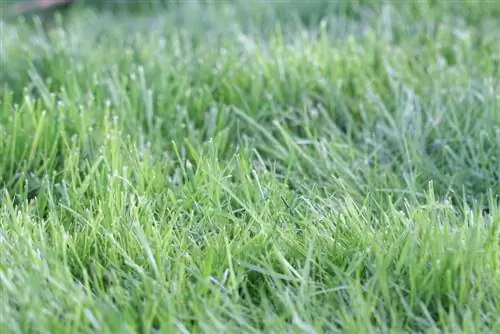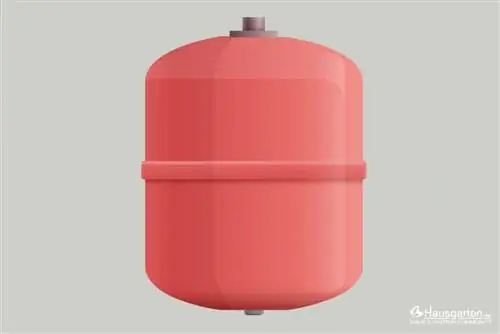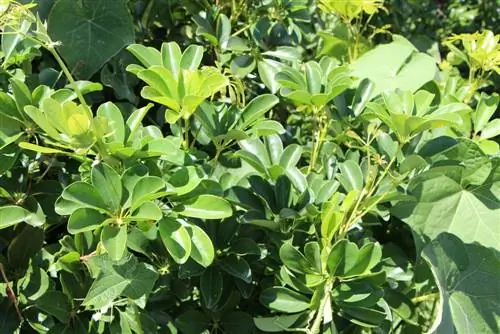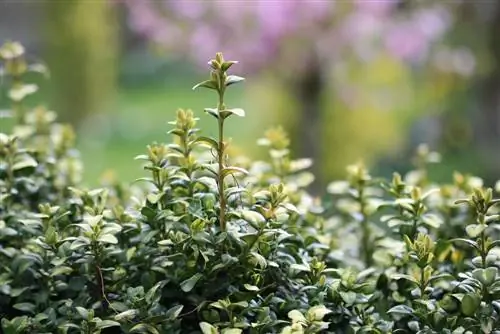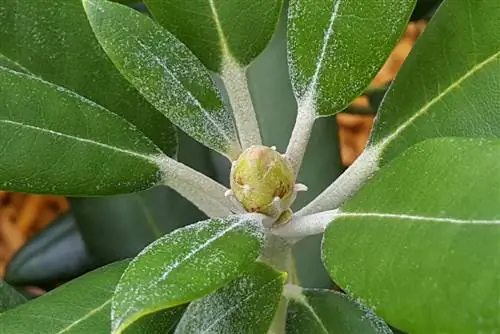- Author admin [email protected].
- Public 2023-12-17 03:39.
- Last modified 2025-01-24 12:45.
When the beautiful green lawn develops all sorts of colors instead of beautiful green, fungi are usually involved; if it doesn't want to grow, fungi, animals or other disorders may be the cause. Often it outgrows, the lawn and lawn almost always need a little additional care, sometimes more needs to be done and you need to know exactly what your lawn is missing. Here is an initial overview of the assessment of the lawn problems, the measures to be addressed are also briefly described:
Lawn diseases from A to M
Anthracnose (Colletotrichum graminicole)
- Season: usually June to August; April, May, September, October possible
- Cause: Fungal disease, attacks weakened plants, e.g. B. due to cutting too deep, dryness, wetness, thatch, lack of nutrients
- Symptoms: Yellowish to reddish-brown irregular spots that look like drought damage, thorn-like growths on the stalks, as well as burns and root damage
- Control/prevention: mow regularly and sparingly, remove grass clippings and leaves and keep the soil well-drained, fertilize in a balanced manner (no nitrogen in autumn), water properly
Leaf spot disease (Drechslera spp., Curvularia spp., Bipolaris spp.)
- Season: Depending on the type of mushroom, March, April, May or August, September, October at temperatures between 10 and 30 °C
- Cause: Fungal disease that attacks weak grasses growing under poor conditions (e.g. moisture due to compaction, grass cutting that is too deep, one-sided fertilization)
- Symptoms: Grasses develop whitish-yellow to brown spots on the stalks
- Control/prevention: see anthracnose, general optimization of growth conditions if partially shaded areas have been covered with the wrong types of grass, replacement with a shade grass mixture (possibly possible through ongoing reseeding)
Brown Patch (Rhizoctonia spp.)
- Season: mid-April to mid-September
- Cause: Fungal disease caused by excess nitrogen or nutrient deficiency, along with high humidity and lack of wind
- Symptoms: On short grass, irregular, grey-green to reddish-light brown spots up to 60 cm, occasionally summer fusarium-like rings with lightened grass, clear identification allows grey-blue, 2-4 cm wide smoke ring on the outer edge of the spots but doesn't always appear
- Combat/prevention: No readily available artificial fertilizer, water in the morning, optimize air supply for quick drying, give potassium in summer
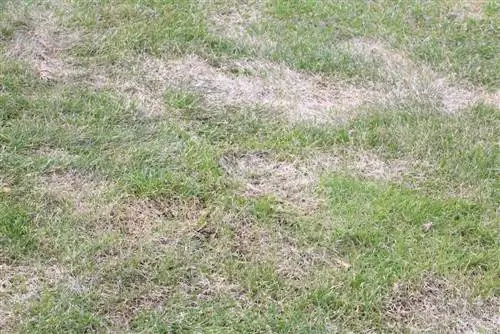
Dollar spot disease (Sclerotinia homoeocarpa)
- Season: May to September, with temperatures from 25°C with cooler nights and dew formation in the morning
- Cause: Fungal disease, affecting plants weakened by drought and lack of nutrients
- Symptoms: sharply defined, light, straw-like spots up to over 10 cm, white fungal tissue visible in high humidity
- Control/prevention: balanced fertilization, optimizing irrigation, ensuring good soil permeability
Dry Patch (dry patches)
- Season: June, July, August
- Cause: Fungal disease caused by soil problems and frequent fungicide use, producing waxy structures
- Symptoms: dry patches, reduced root growth, affected, bone-dry soil next to normally moist areas
- Combat/Prevention: Remove soil compaction and hills, optimize pH value and water nutrient supply, possibly shallow slitting + use of wetting agents
Foreign vegetation
- Season: unfortunately can occur all year round
- Cause: The lawn plants have neither developed sufficiently strong nor sufficiently dense roots to prevent the germination of flying seeds or the spread of moss breeding bodies
- Symptoms: Wild herbs or mosses between the grass plants, which often spread more and more
- Control/Prevention: Check suitability of the lawn seed mixture + growth conditions and improve if necessary; change what the weeds and mosses that act as indicator plants indicate: moss usually indicates compaction, pH values that are too low + too much moisture/shade (can a reasonable lawn even thrive in this location?), with other foreign vegetation, plant type + "Look up pointer plant on the internet
Witch Rings (Marasmius oreades and others)
- Season: possible all year round
- Cause: Fungi that decompose organic substances in the soil (woody root residues) and spread in a ring until cap fungi form above ground when the weather is suitable, favored by nutrient-poor and/or sandy soils
-
Symptoms:
Type 1: Dark green rings with cap mushrooms, waxy mycelium (makes the soil impermeable to water) + secretion of toxins causes grasses to die, mostly between the rings
Type2: Dark green rings with increased grass growth, in which more fungi grow, grasses surviveType3: Mycelium close to the surface, which does not damage the lawn, but only causes increased ring-shaped fungal growth
- Combat/Prevention: Water damaged areas intensively, pierce/tear waxy mycelium, stubborn, severe infestation requires soil replacement, prevent through good soil permeability, balanced fertilization (autumn with a potassium emphasis), keep lawn clear
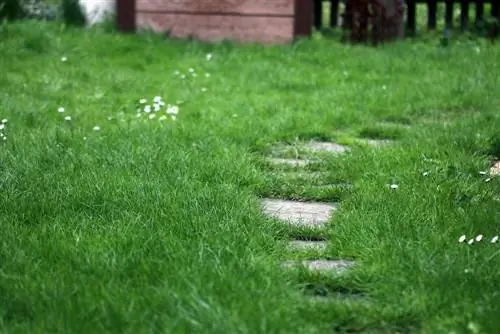
Hills/Ejecta
- Season: can occur all year round
- Cause: mowing so irregularly that individual lawn grasses gain dominance in certain areas; Small animals that dig through the subsoil and build air channels to the surface
- Symptoms: Lawn becomes hillier and grows higher, greener, denser in certain places; Regularly distributed “bumps” with dirt on top
- Combat/Prevention: Mow the lawn more often, scraping off hilltops with the lawn mower or straightening them with the spade + re-seeding the appropriate areas; Fight small animals with great effort or wait until they move on on their own and then sow seeds on the well-loosened soil
Cockchafer grubs (June beetle)
- Season: Grubs hatch from eggs laid in the ground and remain in the ground for 9 months to 4 years until they pupate and emerge from the lawn as cockchafers (cockchafers in May, June beetles in June)
- Cause: The way of the world (also called nature), the famous beetles prefer moist lawns to lay their eggs
- Symptoms: The grubs eat a few roots, which can cause one or two grass plants to die. They also loosen the soil sustainably so that the reseeded lawn can form roots very well
- Combat/Prevention: Do you really want to combat beetles that used to be “the beetles of childhood” and are part of the local cultural heritage (Peterchen’s trip to the moon, Max and Moritz, folk and children’s song “Maykäfer flies”, song “There is no more cockchafers”, Reinhard Mey, “Cockchafer Association”, literary circle of the pre-1848s), are the food source of numerous endangered species and have now become quite rare? If so, you have to develop a sophisticated control plan because chemical agents often do not achieve a satisfactory effect; If not, just wait for the trip and then sow new lawn seeds.
Mildew (Blumeria graminis)
- Season: infestation possible all year round, at temperatures between 0-30 °C
- Cause: Lawns in shaded areas are susceptible, especially a. in warm, humid weather, grass cutting that is too deep and waterlogging
- Symptoms: White, cotton-like pads on the upper side of young stalks, which develop into a mealy coating, towards the end of the vegetation phase small black dots in the older, gray-brown powdery mildew coatings
- Control/Prevention: If possible, improve exposure by thinning shrubs/trees, mow regularly and not too deeply, make soil more permeable; If that doesn't help, sow resistant and shade-tolerant lawn varieties or variety mixtures
Lawn diseases from E to W

Ophiobolus, take-all patch, blackleg (Gaeumanomyces graminis, spp.)
- Season: May, June or August to October
- Cause: Fungal disease, often caused by unnecessary liming that raises soil pH above 7, but can also affect lawn plants stressed by compaction etc.
- Symptoms: Spots of 5-10 cm that turn from dark green to light brown to reddish, then ring formation (larger in the same place every year), stem and root infestation (colored brown to black), grass dies, in the Fight growth with certain resistant herbs
- Control/prevention: soil analysis and appropriate adaptation of the soil
Phytium rot, root burn (Phytium spp.)
- Season: May to September with high humidity and temperature
- Cause: Fungal disease, attacks grasses with low vitality, often subsequent infection after drought damage, even on wet, compacted soils, excess nitrogen, potassium deficiency, high pH values, damaged seeds
- Symptoms: Germination problems in new plants/reseeding, leaf and root rot: small sunken gray to reddish spots that can converge into larger areas, slimy film on the leaves when the air is high, root neck darkly discolored, white mycelium visible when it is damp
- Combat/prevention: optimize the entire soil and supply, buy and sow new seeds
Rust diseases, crown rust, yellow, brown, black rust (Puccinia spp.)
- Season: With the beginning of the warm season from June to September
- Cause: Fungal disease that affects stressed lawn plants; high load, undersupply of nutrients, oversupply of moisture, mowing too deep promotes infestation
- Symptoms: Light yellow spots on the stalk, later yellowish, brown, orange spore beds (depending on the type of fungus), formation of bare areas
- Combat/Prevention: Be sure to bring air into the lawn and allow air to flow in, reseed if necessary, mow more often and not too deeply, optimize remaining growth conditions
Redtip (Corticium fuciforme)
- Season: Temperature range between 5-30 °C, usually March to October, infestation possible all year round
- Cause: Fungal disease caused by excessive moisture in the lawn and/or a lack of nutrients (nitrogen deficiency)
- Symptoms: Light yellow to brownish discolored grass blades, reddish, antler-like fungal plexus when wet
- Control/prevention: Mow regularly (max. 1/3 blade length), remove grass cuttings and leaves, avoid thatch, pay attention to permeable soil, no nitrogen fertilizer in autumn, avoid drought stress=water enough
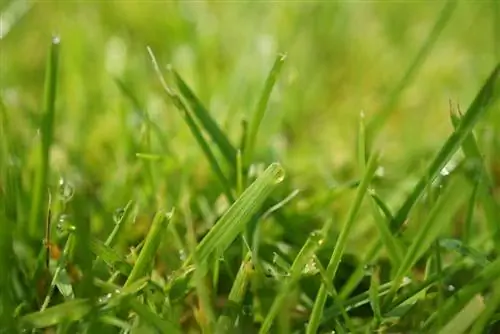
Slime molds (Mycetozoa or Eumycetozoa)
- Season: Ideal growing conditions on poorly ventilated lawns in the summer months, especially. a. in warm, humid weather
- Cause: Fungi decompose organic substances in the soil (e.g. wood or root residues) and should do so as long as the fungal network remains underground. Occasionally these decomposers, which are harmless in contrast to the witch mushrooms, sometimes come to the surface
- Symptoms: Underground distribution without symptoms, when the fungus comes to the surface, fruiting bodies (slime-like deposits in yellow, orange or purple) settle on the stalks until a grassy area covered with a streaky coating is formed
- Combat/Prevention: Slime molds disappear on their own after days or weeks and do no harm; an illness only for people who classify every natural phenomenon that goes out of hand as a disease; For the rest, an indication that the oxygen supply to the soil is restricted and the lawn needs to be given more air so that it is sufficiently supplied with nutrients again
Snow mold (Microdochium nivale/Gerlachia nivalis)
- Season: September to March, despite infestation in autumn, the first signs are often only noticeable after the snow melts in spring
- Cause: Fungal disease, wet rot, affects plants weakened by over-fertilization (nitrogen fertilization in autumn), compacted soil (wetness) and high temperature fluctuations
- Symptoms: 3-4 cm large circular, brownish spots that grow to 30 cm and can combine to form larger, coherent areas. In high humidity, gray-white to pink mycelium at the edge (also as a mixed infection with typhula)
- Combat/Prevention: Heals on its own when it is warm, preventive measures include regular mowing that is not too deep (max. 1/3 of the blade length), ensuring that the soil is permeable, balanced fertilization (potassium-based in autumn), leaves and grass clippings remove
Summer Fusarium (Fusarium spp.)
- Season: June to September with temperatures above 25°C and high humidity
- Cause: Fungal disease, affecting grass weakened by e.g. one-sided fertilization, compacted soil, thatch, drought
- Symptoms: Surfaces become light green and later change color to light brown to reddish brown, in high humidity, reddish fungal mycelium can be seen at the edge, during regeneration from the center, rings or eyes form
- Combat/Prevention: Heals itself in warm and dry conditions, preventive measures such as snow mold
Typhula rot(Typhula incarnata), Root neck rot (Grey snow mold)
- Season: November to March at temperatures around 0°C
- Cause: fungal disease, dry rot, weak plants due to over-fertilization (nitrogen fertilization in autumn), compacted soil (wet)
- Symptoms: Irregular (light) brown spots up to 50 cm, when damp, light gray fungal network similar to Microdochium nivale, but leaves appear dry and papery (also as a mixed infection with snow mold)
- Combat/Prevention: Heals on its own in warm temperatures, preventive measures like snow mold
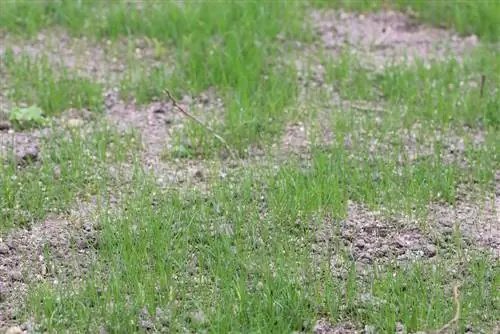
drought
- Season: possible all year round if the ground is not frozen
- Cause: inadequate irrigation, if this occurs repeatedly, possibly the wrong grass seed mixture
- Symptoms: stalks become light green, limp, yellow, dry
- Combat/Prevention: Water the lawn properly (not in the sun, sufficiently at larger intervals instead of often little), enrich the soil if there is a lack of root formation, cover the lawn with suitable grasses in full sunlight (possibly possible by reseeding)
Meadow crane larvae (Tipula spec.)
- Season: August, September, April, May, v. a. in well-moisturized lawns with nice, loose soil
- Cause: Meadow flies want to reproduce and need good, moist, loose soil “so that the children have a good time too”
- Symptoms: Root damage causes individual light spots with slightly reduced growth and at the same time a strong loosening of the soil that no machine would be able to do so gently on the plants
- Control/Prevention: Can be controlled in rare, extreme mass infestations with nematodes (control with pesticides is not permitted), but here the same applies as for the cockchafer grub. Hair midges (Bibio spec.) act in a similar way, but do little harm and have almost fled before any idea of combating them.
Conclusion
In summary, it is noticeable that all lawn diseases and lawn problems only turn into visible trouble if the lawn is positioned incorrectly, the soil under the lawn is incorrect, the lawn seed mixture is incorrect for the given location, the wrong diet is used or the grass plants are treated incorrectly. Which in turn means that you will save a lot of time on information about and combating lawn diseases if you find out enough (before planting the lawn) about what grass plants need in order to grow together into a lawn that thrives willingly and easily in the surrounding nature.

